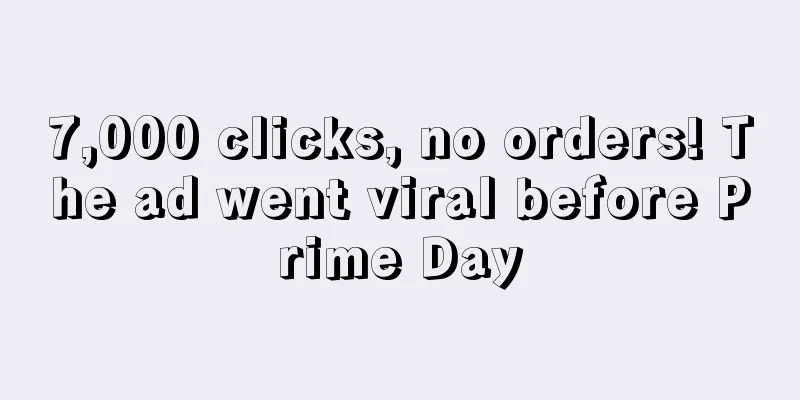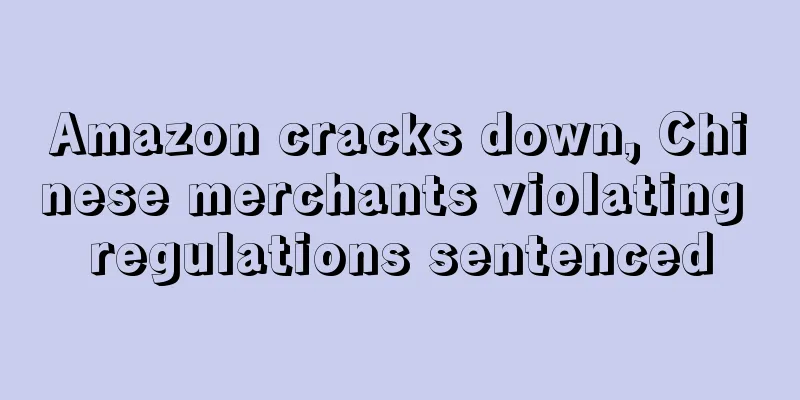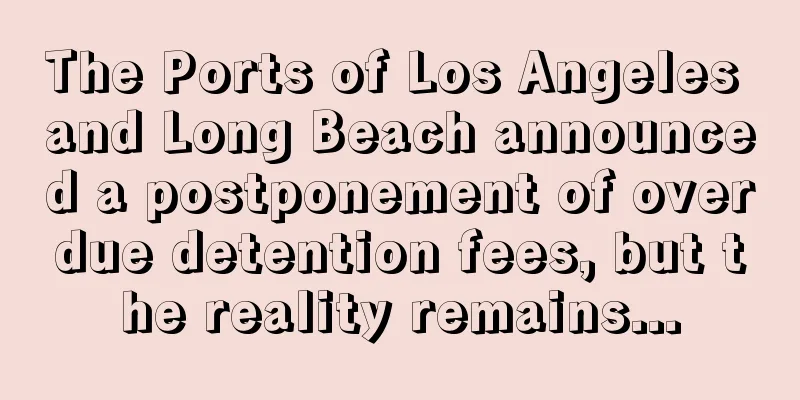7,000 clicks, no orders! The ad went viral before Prime Day

|
As the advertising tug-of-war unfolded, sellers' advertising exploded. Among them, one seller's display advertising costs soared three times, and spent a month's expenses in one day. However, when advertising costs soared, sellers' orders did not increase accordingly. One seller spent nearly $5,000 on advertising, but did not receive a single order. Industry insiders couldn't help but complain: "It was Amazon that drove the advertising costs up!"
At a time when Amazon sellers’ operating costs are soaring, high advertising costs will undoubtedly further impact sellers’ profits. In order to ensure that the store continues to receive orders and the capital chain is not broken, advertising fees and profits may be the straw that keeps sellers alive.
Sellers’ ads exploded before Prime Day
Prime membership day is approaching, and many sellers have reported recently that orders have not exploded, but advertisements have exploded!
Wang Tianyu, a seller in the home products category on Amazon, said, “We have a sticker with a per-order price of about US$10. Recently, ad clicks have surged, with Acos soaring to nearly 300%. A week’s advertising costs are about US$200, and the cost of a single click has exceeded US$2.”
Wang Tianyu's home furnishing category is also a category with fierce advertising bidding. In addition, competition in 3C, clothing and other categories has also entered a white-hot stage. In addition to large categories, advertising in other small categories has also soared.
Before the big sale, Amazon sellers in multiple categories are increasing their advertising budgets to gain link weight and exposure and win more orders.
One seller sold a product for $9.9, but Amazon suggested a bid of more than $6. There was also a seller selling a product for $4.99, but the suggested bid was as high as $2.6. A colleague said, "This kind of advertising bidding is what we were familiar with before Prime Day. "
Many sellers are suffering from the sharp increase in advertising fees. More similar feedback is as follows:
“——Why are advertising costs so high today? ——Burning $900 in 7 days, not a single order was placed; ——Only click to place an order; ——Advertising costs $1,000 per day, accounting for two-thirds of the total; ——Acos is getting higher and higher, and conversion is getting lower and lower; ——$100 an hour for big keywords is gone, and Amazon recommends a daily budget of $300; ——Looking at the advertising costs, I feel like I’m going to lose a lot of money…”
In the words of veteran seller Li Fei: "If you don't invest, someone else will. Before the big promotion, most of your peers will increase their advertising budgets by 2-3 times."
Advertising costs have increased significantly, but conversion rates are not as good as before. One seller spent $100 on advertising, but did not get a single order. The seller said that the new product advertisement ran for two days and cost more than $100, but still had no orders. If he continued to spend advertising money without getting any orders, he would have to go into a low-price spiral.
Even the advertising costs of old products are soaring on Prime Day, so it is even more difficult to launch new products at this time. Many sellers who are promoting new products have no choice but to start selling at a low price after spending a lot of money on advertising but still fail to get orders, trying to accumulate a certain amount of reviews first and then increase their advertising budget.
Increasing the advertising budget is one aspect, but on the other hand, some sellers have discovered that the increase in advertising costs seems a bit abnormal, as they actually spend a month's worth of fees in one day.
The seller said that since July, the exposure and click volume of his display product ads have suddenly increased by more than three times. Specifically, one display ad cost $200 a day, which was only the same amount a month ago; another display ad cost more than $1,000 a month ago, but in the past three days, it has cost about $1,700 a day.
A lot of money was spent on advertising but no orders were received. According to this seller, the product was clicked nearly 7,000 times and he spent $4,800, but not a single order was received.
This situation is not unique to this seller. Other sellers have also encountered this problem. The seller's advertising expenses have always been low, but in July, the advertising expenses suddenly increased sharply. In response, many sellers were puzzled and did not know why this "accident" occurred.
Li Fei said frankly that there are too many cases where advertising costs are high but no orders are made, which is due to poor conversion. The poor conversion may be related to Amazon's strategy.
Nowadays, Amazon explicitly encourages sellers to engage in branding, and the platform will also increase its traffic support for brands accordingly. If sellers do not engage in branding operations, they may lose the entrance to traffic. Although they increase advertising investment, your ad bounce rate is also high, resulting in low conversion rates, only advertising expenses, and no orders.
Another situation is that sellers are unable to spend their advertising costs. This phenomenon has occurred more frequently since March this year.
Wang Tianyu said that according to the sellers in the industry, Amazon is now focusing on the Japanese market and the Brazilian market in South America. Brazil is a new market and will receive corresponding support. Amazon's investment promotion team has also been encouraging sellers to open Brazilian sites. The platform believes that the North American market is already saturated and recommends that sellers divert traffic from outside the site.
Li Fei said that Amazon is currently encouraging sellers to conduct branding and refined operations. It is obvious that some links with good management and high weight will see a surge in traffic even without increasing advertising investment. If the link is not good, no matter how much advertising is invested, it will not be spent. Amazon's traffic is also limited. In order to increase sales, the platform will definitely allocate traffic to products with excellent performance.
Therefore, this year, more sellers are facing the problem of no orders despite a sharp increase in advertising costs. It is likely that Amazon is making adjustments. The platform needs to give more traffic to sellers who provide customers with high-quality products and services to better improve the buyer experience.
Sellers: Amazon drives advertising costs high
Amazon has never stopped adjusting its advertising, and has been withdrawing various types of advertising and guiding sellers to give it a try.
Some sellers found that before Prime Day, Amazon quietly updated the display advertising function Contextual Targeting, which updated the product delivery in the previous display advertising, making the function appear more powerful.
Amazon has informed sellers that Amazon Advertising will find the best opportunities to display contextually relevant ads based on your bid optimization and targeting options. Contextual relevance targeting is an upgrade to product delivery that expands reach on contextually relevant third-party websites and apps. This also means that sellers can continue to use product detail page options to sell your products or related products on Amazon.
Some sellers concluded that the updated display ads are very similar to DSP ads. However, DSP ads can only be operated by Amazon staff, and after the update, the products, categories and relevance of the ads are set by the sellers themselves.
Amazon has been continuously updating various advertising features, but with fierce competition for traffic, some sellers have not achieved the desired results after using the new advertising features.
Since the beginning of this year, sellers' advertising costs have continued to rise, especially with the recent Prime Day promotion approaching, advertising costs have continued to grow. Some sellers believe: " The high bidding prices for Amazon's on-site advertising are likely to be fueled by the platform's official team behind the scenes . "
An industry insider couldn't help but complain: "Amazon is brainwashing sellers from all aspects and channels to run all kinds of ads and not to deny related keywords. This will undoubtedly increase the seller's ad click cost, increase the number of clicks, and ultimately increase the total cost of advertising several times."
The person believes that Amazon's advertising is pervasive through backstage, registered email and other channels, encouraging sellers to run more ads and spend more advertising fees. Nowadays, investment managers will also explicitly ask sellers about their annual advertising budget and guide sellers to increase their advertising budgets. In this way, the performance of Amazon's advertising department has been greatly improved, and sellers' expenses have also been greatly increased. Nowadays, Amazon's natural traffic entrances are getting fewer and fewer, and sellers have to run various advertisements to increase traffic and exposure.
Some sellers agree with this, saying that Amazon’s advertising data is not good, which will lower the natural ranking, but managers rarely mention this issue, which misleads many operations and causes many sellers’ links to fail to last long. Sellers continue to launch new products and spend a lot of money on advertising.
As sellers’ advertising budgets increase, Amazon’s advertising revenue is also rising, contributing a lot to its revenue.
According to the advertising revenue data released by Amazon, Amazon's advertising revenue in 2021 reached 32.6 billion US dollars, a year-on-year increase of 55%, of which the advertising revenue in the fourth quarter accounted for nearly one-third of the annual advertising revenue. In the past three years, the revenue of Amazon's advertising services was 11 billion US dollars, 10.9 billion US dollars and 16.9 billion US dollars respectively, increasing year by year.
This year, Amazon's advertising costs may reach a higher level, as can be seen from the sellers' continuous increase in advertising investment.
The non-stop advertising flywheel
In the first half of the year, sellers frequently mentioned the increase in advertising costs. In order to achieve good results in the Member Day promotion, sellers have made a series of preparations, one of which is to obtain traffic and increase advertising to maintain normal capital turnover.
Currently, bidding in many categories on Amazon has risen sharply. One of the reasons for this situation is that the shortcut to fake orders has been shut down.
Wang Tianyu mentioned that last year's account suspension incident had a huge impact on sellers in Guangzhou and Shenzhen. Now they have greatly restrained themselves from fake orders, but to maintain sufficient traffic, they need sufficient exposure, so advertising investment has become an important way to attract traffic, and the intensity of advertising is very high. In addition, the frequency of price reduction and off-site promotion has also increased significantly.
Li Fei analyzed that Amazon's traffic is divided into two types, one is push traffic and the other is search traffic. Nowadays, most sellers are doing business on their own, and the largest traffic points in this regard are on the site. The best way to get traffic on the site is advertising. When everyone pays attention to advertising and puts in advertising, the cost explodes, and advertising pricing is bound to rise. "Especially in some discounted categories, if you don't advertise, there will always be someone who will advertise. In 2019 and 2020, a large number of sellers poured in, and the number of sellers doubled, but the market is so big, and the traffic on the site is so much, whoever gets it gets it."
In this case, the sales target of some hot-selling categories has shifted from ensuring profits to ensuring funds, especially for big sellers, which need to ensure that the capital chain is not broken and continues to flow.
"Survival is the most important thing. Now the main thing for big sellers is to ensure a continuous capital chain. Converting goods into funds is their top priority, so this situation is very unfriendly to small and medium-sized sellers."
Before the peak season arrives, Membership Day is the sales trump card in the first half. Winning this battle is crucial for both sellers and platforms.
Prime Day will still set records, Amazon gives a hint
More than 80% of U.S. consumers have access to a Prime account, according to a recent report from research firm Coresight, and such high coverage makes Amazon Prime Day sales highly anticipated.
A June Adobe survey found that 24% of consumers do not plan to shop on Prime Day because they have less discretionary money due to inflation, while 61% are looking forward to summer sales like Prime Day. Of those who plan to attend summer sales, 76% said they will spend the same amount or more than last year.
This year, though, consumers may be less interested in backyard entertaining or flash sales like Black Friday and more eager to score discounts on essentials to offset runaway inflation.
How to maximize traffic, attract consumers and convert them? Amazon gives a few tips:
1. Share the small business sweepstakes with customers. Highlight your “small business” features and share the Prime Day small business sweepstakes with customers on social media before July 11. Customers must enter the sweepstakes before purchasing, and then for every $1 spent on products sold by small businesses, customers have a chance to win a prize. Sellers can join the conversation using the #SupportSmallwithAmazon tag on Instagram, Twitter and Facebook;
2. Offer coupons for best seller products. Coupons are a great way to stimulate purchases, especially during Prime Day. For products you want to discount, you can create coupons, and then when your product appears in search results, there will be a green coupon label showing the discount;
3. Prepare your advertising budget for higher traffic. During peak shopping events such as Prime Day, your ads may receive more traffic and clicks than usual, and your spending will exceed your budget faster. Once the budget is exceeded, your ads will be suspended until midnight the next day, and you can increase your budget according to the rules.
4. Adjust the selling price to stay competitive. When adjusting your promotional campaigns, set your bid to the highest amount you are willing to pay per click to stay competitive. You can also choose to lower your bid at any time in seconds. In product promotion campaigns, you can use dynamic bidding to increase bids for impressions that are likely to convert to sales in real time and lower bids for impressions that are less likely to convert to sales, which helps focus Prime Day spending on high-quality clicks and reduce spending on low-impact advertising.
Additionally, there are more Prime Day preparation tips for Brand Registry sellers, including:
5. Create a Prime Day version of your store. Use the store planning feature to create a Prime Day version of your store and submit it for approval at least one week before the big sale. When you submit it for approval, you can choose the date you want the Prime Day version of your store to be released, and the date you want the store to revert to another version.
When preparing your store for Prime Day, make sure to add a page for the Featured Deals widget. This is a great way to increase visibility of products on sale, such as Lightning Deals, Coupons, or Subscribe & Save. The widget automatically updates, so products will only appear in the widget during the promotion period.
6. Advertise through non-Amazon channels and get bonuses. Promoting products and deals through non-Amazon channels before and during Prime Day can help expand your reach, engage your current customer base, and increase sales rates. When you sign up for a brand referral bonus, you can get an average bonus of 10% of the sales price generated by non-Amazon marketing activities. The bonus you receive will be used as a referral fee for future transactions until the bonus is used up;
7. Allow time for review. Creative-based shopping experiences (such as brand flagship stores or A+ content) require review before release. Make sure you leave enough time for the creative to be approved so that you don’t miss out on traffic and potential sales opportunities. In addition, if any of your ad creatives are not reviewed and approved, you must revise and resubmit for approval, which will delay release.
Sellers need to allow at least one week for most creative-based shopping experiences and be prepared for possible delays. Shopping experiences that need to be reviewed include Stores, Sponsored Brands and Sponsored Display campaigns, Posts, and A+ Content.
8. A/B test product detail pages. Manage Your Experiments allows you to run A/B tests on your brand’s product detail pages to see which version performs better and publish the better performing version of the content. This feature allows you to test three different elements of the product detail page - product images, product titles, and A+ content.
With less than a week to go before the promotion begins, most participating sellers are ready. Even if the growth is slower than in previous years, this Prime Day is likely to set a new sales record.
Research firm Numerator predicts that Amazon will gain more than 20% of the consumer packaged goods (CPG) share during next week's Prime Day promotion. During the promotion period, this share is four to five times higher than usual. For example, in 2021, Amazon's CPG share was 4.7% in the month before Prime Day, 5.7% in the month of Prime Day, and 19.1% during Prime Day. It can be seen that the performance of the promotion day is strong.
The study also revealed this year's shopping trends. For example, many consumers will use Prime Day to start back-to-school and holiday shopping. Among the respondents, 22% of shoppers said they plan to buy gifts for birthdays, anniversaries and other special occasions; 18% plan to buy holiday gifts; and 10% plan to buy back-to-school supplies. In addition, about 1/5 of consumers are waiting for big-ticket items to be sold on, and 17% will buy discounted high-priced items.
Still, financial concerns are keeping some consumers from shopping. Focusing on saving money (39%), inflation/price increases (36%) and a lack of sales on specific items (34%) are the top three reasons cited by people for not planning to shop this year.
Analysts predict that due to factors such as inflation and platform investment, the upcoming Prime Day will no longer be as strong as it was during the COVID-19 pandemic. Insider Intelligence predicts that Prime Day sales for US retailers such as Amazon will grow by 17% in 2022, far lower than the huge increase when the promotion was just launched a few years ago.
Sellers no longer have the enthusiasm they had a few years ago. They will clear out some of their overstocked inventory through big sales, or achieve more impressive results with lower profits, but they will no longer rely on this Member Day to turn things around.
Amazon Prime Day advertise |
>>: With over 14,000 five-star reviews, another hit product from Amazon is released!
Recommend
What is MiniCurrency? MiniCurrency Review, Features
Minimalist Exchange Rate Minimalist Exchange Rate ...
“Large appliances” are hot on Amazon’s Western European marketplace
Recently, Thrasio Research analyzed data from Sma...
What is Payeer? Payeer Review, Features
<span data-docs-delta="[[20,{"gallery"...
What is KBZPay? KBZPay Review, Features
KBZPay is a mobile wallet from Myanmar’s KBZ Bank...
What is Journey to the West Cross-border Logistics? Journey to the West Cross-border Logistics Review, Features
Since its inception, Xiyou Cross-border has focuse...
Amazon spends over 10 billion to acquire "Big Seller", facing antitrust investigation in the UK and the US
When Amazon announced its $1.7 billion (about 11....
What is Express Logistics? Express Logistics Review, Features
Shenzhen Kuaijie Supply Chain Management Co., Ltd...
What is Impact? Impact Review, Features
Impact Help partners accelerate business growth an...
What is Commercial Invoice? Commercial Invoice Review, Features
Commercial Invoice, also known as invoice in fore...
What is OpeningCeremony? OpeningCeremony Review, Features
Opening Ceremony is one of the most successful bou...
Stop Asian Hate! Shopify creates new Shop catalog to support Asian brands
Canadian website building platform Shopify has ex...
What is BOKU? BOKU Review, Features
<span data-docs-delta="[[20,{"gallery"...
To promote sustainable development, retailers limit the number of orders customers can place each year
Recently , Toward , an online luxury retailer foc...
What is Decathlon? Decathlon Review, Features
Decathlon is a French sporting goods retailer fou...
What is iextrans? iextrans Review, Features
Meihuan (Shanghai) E-Commerce Co., Ltd. is a serv...









